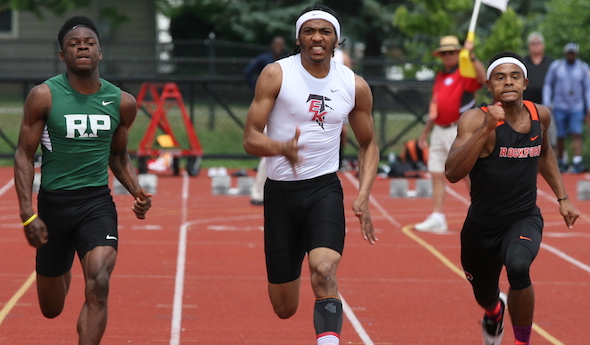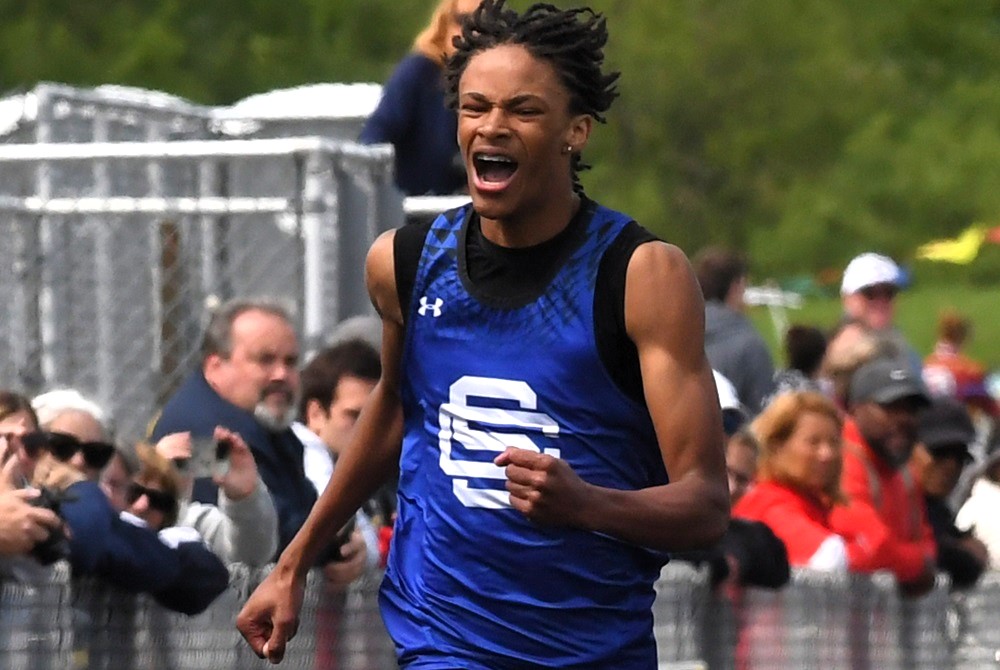
Meyers Gives Kentwood Crowd Final Show
By
Paul Costanzo
Special for MHSAA.com
June 3, 2017
Khance Meyers put on one final show in an East Kentwood uniform Saturday, and did it on his home track.
The senior sprinting star won the 100 and 200 meters for the second straight year at the Lower Peninsula Division 1 Boys Track & Field Finals, and anchored the winning 800 relay team also to a repeat championship.
“Doing all this on my home turf feels amazing,” said Meyers, who also anchored the runner-up 1,600-relay team. “Just knowing that you’re at home, competing against the best, the top in the state, some even nationally ranked, it’s just amazing. Coming out here, giving the fans what they want, giving them a show – all I can say is I thank God that I’m able to do this.”
Meyers’ performance led an all-around remarkable day for the Falcons, who finished with 78½ points to claim their first MHSAA team title since 2014. It was the school’s sixth title under coach Dave Emeott. Rival Rockford was second with 62 points, followed by defending champion Oak Park in third with 44.
“Ultimately it was a full team approach,” Emeott said. “We won a bunch of events, and we set a state record in the long jump and ended up second place; that doesn’t happen very often. Our kids were on fire, every event. I’m so proud of them.”
Meyers set the Division 1 meet record in the 100 meters with his time of 10.53 seconds. He just missed breaking his own 200-meter record, winning in 21.27. He joined teammates Al Jeffries, Jacobie Welch and Stephan Bracey to run 1:26.07, breaking the Division 1 meet record East Kentwood set a year ago.
“People ask me all the time, ‘Khance, how does it feel to be No. 1 in the state?’ or ‘How does it feel to be competing at the top level?’” Meyers said. “Just being No. 1 in the 100, 200 and dropping your times -- all I can say is, I just thank God.”
Meyers wasn’t the only Falcon to take home an individual title, as sophomore thrower Logan Brown won the shot put with a toss of 60 feet, 1½ inches.
He also wasn’t the only record setter on the day. Salem’s Mason Phillips won the long jump with a leap of 24-2¾, the best mark not only in Division 1 meet history, but for all Finals.
Rockford’s 400-meter relay team did the same, as their time of 41.2 seconds is a new top mark in MHSAA Finals history. The team included Melvin Moseley, Noah Stallworth, Josh Patterson and Nicholas Isley.
Like Meyers, Oak Park’s Cameron Cooper came away with three titles and one runner-up finish. He won the 800 in 1:51.22, teamed with Dewan Hawthorne, Bryce Pickett and Javonne Kirksey to win the 1,600 relay in 3:17.58, and teamed with Hawthorne, Kirksey and Michael Campbell to win the 3,200 relay in 7:44.85. He was second in the 1,600 meters, edged out at the line by Rockford’s Cole Johnson.
“I just ran it,” Cooper said of the 800. “I had to come back after all of those events -- I can’t really feel my legs. I’m kind of used to (running four events) because I do it throughout the year, sometimes even doing two meets a week. I’m really strong, so I can come back and still run the same thing.”
For Johnson, his 1,600 win was a redemption story. He stumbled early in the race a year ago, but bounced back to take third. This year, he got out fast and won in 4:08.60, despite a late push from Cooper.
“Since I wanted to run fast, I had to be out there pushing the pace,” Johnson said. “I definitely learned from my fall last year to get out fast. I knew that I could go out in sub-60 (seconds on the first lap) because that’s what I went out at in an MSU meet earlier this year. I definitely wanted to get out fast.”
East Lansing’s Kentre Patterson doubled in the hurdle races, winning the 110 in 13.84 and the 300 in 38.23 seconds despite not running in the final heat. It was the second straight title for Patterson in the 110 hurdles.
“I always love competition, but being in the slow heat, kind of controlling the race was pretty good,” Patterson said. “It let me relax and do my own thing. I didn’t put my clothes back on until after (the final heat).
“I just had it in my head that this is the last race of the season, last time running the 300 hurdles. My coaches had me thinking about it all week, telling me I could do it coming out of the slow heat.”
Ypsilanti Lincoln’s Matthew Moorer won the 400 meters in 47.42 seconds. Fenton’s Dominic Dimambro won a tight 3,200-meter race in 9:07.79.
Randy Prince of Portage Northern won the discus with a throw of 173 feet. Connor Bush of Plymouth won the high jump with a jump of 6-6. Cale Snyder of Macomb Dakota won the pole vault, clearing 15-6.
PHOTO: East Kentwood's Khance Meyers pushes past his competitors during a sprint win Saturday. (Photo by Carter Sherline/RunMichigan.com.)

Performance of the Week: Southfield Christian's Brock Morris
June 5, 2025
 Brock Morris ♦ Southfield Christian
Brock Morris ♦ Southfield Christian
Senior ♦ Track & Field
Morris finished an individually-phenomenal day at Saturday's Lower Peninsula Division 4 Finals by helping his teammates make school history. With Southfield Christian trailing leader Kalamazoo Hackett Catholic Prep by three points heading into the final event of the day, Morris anchored the Eagles' 1,600 relay and crossed the finish line first – which, combined with Hackett's third-place finish in the race, gave Morris and his teammates their school's first Finals team championship in track & field by one point.
That victory capped a day that also saw Morris win the 200 and 400-meter open races and run on the winning 800 relay as well. Morris was part of school records in all four of those races this season and the 400 relay as well; the 1,600 relay time of 3:24.36 on Saturday lowered that school record and also included Dylan Taylor-Wilkerson, Robert Brown and Jadon Staten. Morris also ran cross country and played point guard on the boys basketball team. He will study at University of Michigan, majoring in biology, health and society on a pre-medical track.
@mhsaasports 🏃♂️POW: Brock Morris #southfieldchristian #track #finals #winner #1600relay #anchor #part1 #highschoolsports #tiktalk #interview #performanceoftheweek #mistudentaid #fyp #MHSAA ♬ original sound - MHSAA
@mhsaasports 🏃♂️POW: Brock Morris #instagram #chocolatemilk #hidden #talent #emoji #part2 #performanceoftheweek #mistudentaid #fyp #MHSAA ♬ Monkeys Spinning Monkeys - Kevin MacLeod & Kevin The Monkey
Follow the MHSAA on TikTok.
MHSAA.com's "Performance of the Week" features are powered by MI Student Aid, a division within the Department of Lifelong Education, Advancement, and Potential (MiLEAP). MI Student Aid encourages students to pursue postsecondary education by providing access to student financial resources and information. MI Student Aid administers the state’s 529 college savings programs (MET/MESP), as well as scholarship and grant programs that help make college Accessible, Affordable and Attainable for you. Connect with MI Student Aid at www.michigan.gov/mistudentaid and find more information on Facebook and Twitter @mistudentaid.
Previous 2024-25 honorees
May 30: Chloe Qin, Bloomfield Hills Cranbrook Kingswood tennis - Report
May 23: Drew Goik, Bay City Western golf - Report
May 15: Sydney Kuhn, Saginaw Swan Valley track & field - Report
May 8: Ryan Bosch, Fruitport baseball - Report
May 1: Jackson Lam, Kalamazoo Loy Norrix track & field - Report
April 25: Isabelle Horvath, Bangor softball - Report
April 18: Presley Jones, Sterling Heights Stevenson soccer - Report
April 11: Olivia Jasniewicz, Troy soccer - Report
March 27: Katie Spicer, Fowler basketball - Report
March 21: Moses & Markus Blackwell; Warren Lincoln basketball - Report
March 13: Keyshawn Summerville, Lansing Sexton basketball - Report
March 6: Maggie Buurma, Fowlerville wrestling - Report
Feb. 28: Maren Studt, Pontiac Notre Dame Prep skiing - Report
Feb. 21: Olive Krueger, Marquette swimming - Report
Feb. 14: Hunter Lemmon, Fraser swimming - Report
Feb. 7: Aubrey Hillard, Rochester competitive cheer - Report
Jan. 31: Wyatt Spalo, Reed City wrestling - Report
Jan. 24: Olivia Flynn, Harbor Springs basketball - Report
Jan. 17: Levi Rozema, Holland Christian swimming - Report
Jan. 10: McRecco McFadden, Burton Bentley basketball - Report
Dec. 18: Nash Leonard, Bay City Western hockey - Report
Dec. 11: Blake Cosby, Dundee wrestling - Report
Dec. 4: Keaton Hendricks, Zeeland West football - Report
Nov. 29: Kate Simon, East Grand Rapids swimming - Report
Nov. 22: Ella Kokaly, Essexville Garber volleyball - Report
Nov. 15: Caroline Bryan, Grosse Pointe South swimming - Report
Nov. 8: Kaylie Livingston, Whitmore Lake cross country - Report
Oct. 25: Oliver Caldwell, Grand Rapids West Catholic tennis - Report
Oct. 18: Alex Graham, Detroit Cass Tech football - Report
Oct. 11: Victoria Garces, Midland Dow cross country - Report
Oct. 4: Asher Clark, Bay City John Glenn soccer - Report
Sept. 26: Campbell Flynn, Farmington Hills Mercy volleyball - Report
Sept. 19: TJ Hansen, Freeland cross country - Report
Sept. 12: Jordan Peters, Grayling soccer - Report
Sept. 6: Gabe Litzner, Sault Ste. Marie cross country - Report
Aug. 30: Grace Slocum, Traverse City St. Francis golf - Report
(Photo by RunMichigan.com.)

